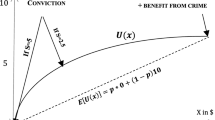Abstract.
A dynamic general equilibrium model of larceny – or property crime – is presented in which both economic conditions and government policies affect the commission calculus. The model provides a behavioral framework that is used to estimate the effects of government policies on the commission of larceny. Calibrating the model using data from cities in Los Angeles County, the impact of a number of government policies and of economic development on larceny are quantified. The simulations show that longer prison sentences and higher conviction rates for criminals are the most effective methods to reduce larceny; subsidizing leisure activities, increasing police expenditures and income transfers have little effect on larceny. Using a game-theoretic optimality criterion, all the policies examined are currently overfunded.
Similar content being viewed by others
Author information
Authors and Affiliations
Additional information
Received: August 1998 / Accepted: July 1999
Rights and permissions
About this article
Cite this article
Zak, P. Larceny. Econ Gov 1, 157–179 (2000). https://doi.org/10.1007/PL00021680
Issue Date:
DOI: https://doi.org/10.1007/PL00021680



